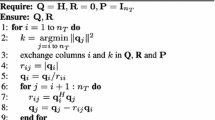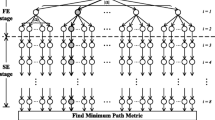Abstract
Recently, high spectral and energy efficiencies multiple antennas wireless systems under scattered environments have attracted an increasing interest due to their intrinsically benefits. This work focuses on the analysis of MIMO equalizers, improved MIMO detection techniques and their combinations, allowing a good balance between complexity and performance in Rayleigh channel environment. Primarily, the MIMO linear equalizers combined with detection techniques such as ordering (via sorted QR decomposition), successive interference cancellation, list reduction and lattice reduction were investigated. An important aspect invariably present in practical systems taken into account in the analysis has been the channel correlation effect, which under certain realistic conditions could result in a strong negative impact on the MIMO system performance. The goal of this paper consists in construction a framework on sub-optimum MIMO detection techniques, pointing out a MIMO detection architecture able to attain low or moderate complexity, suitable performance and full diversity.







Similar content being viewed by others
References
Bai, L., & Choi, J. (2012). Low complexity MIMO detection. Berlin: Springer.
Biglieri, E. (2007). MIMO wireless communications. Cambridge: Cambridge University Press.
Boccardi, F., Heath, R., Lozano, A., Marzetta, T., & Popovski, P. (2014). Five disruptive technology directions for 5g. IEEE Communications Magazine, 52(2), 74–80. doi:10.1109/MCOM.2014.6736746.
Bolcskei, H. (2006). Mimo-ofdm wireless systems: Basics, perspectives, and challenges. IEEE Wireless Communications, 13(4), 31–37. doi:10.1109/MWC.2006.1678163.
Choi, J., & Nguyen, H. (2009). SIC-based detection with list and lattice reduction for mimo channels. IEEE Transactions on Vehicular Technology, 58(7), 3786–3790.
Cox, A., Higham, N. & Manchester Centre for Computational Mathematics. (1997). Stability of householder QR factorization for weighted least squares problems. Numerical analysis report, Manchester Centre for Computational Mathematics.
Fischer, R. F. H., & Windpassinger, C. (2003). Real versus complex-valued equalisation in V-BLAST systems. Electronics Letters, 39(5), 470–471. doi:10.1049/el:20030331.
Gan, Y. H., Ling, C., & Mow, W. H. (2009). Complex lattice reduction algorithm for low-complexity full-diversity MIMO detection. IEEE Transactions on Signal Processing, 57(7), 2701–2710. doi:10.1109/TSP.2009.2016267.
Gander, W. (1980). Algorithms for the QR decomposition. Technical report, Eidgenössische Technische Hochschule, Zürich. www.inf.ethz.ch/personal/gander/papers/qrneu.pdf.
Goldsmith, A. (2005). Wireless communications. Cambridge: Cambridge University Press.
Golub, G. H., & Van Loan, C. F. (1996). Matrix computations (3rd ed.). Baltimore, MD: Johns Hopkins University Press.
Hassibi, B., & Vikalo, H. (2005). On the sphere-decoding algorithm. I. Expected complexity. IEEE Transactions on Signal Processing, 53(8), 2806–2818. doi:10.1109/TSP.2005.850352.
Jalden, J., & Ottersten, B. (2005). On the complexity of sphere decoding in digital communications. IEEE Transactions on Signal Processing, 53(4), 1474–1484. doi:10.1109/TSP.2005.843746.
Kim, I. M. (2006). Exact BER analysis of OSTBCs in spatially correlated MIMO channels. IEEE Transactions on Communications, 54(8), 1365–1373. doi:10.1109/TCOMM.2006.878823.
Kühn, V. (2006). Wireless communications over MIMO channels—Applications to CDMA and multiple antenna systems. Chichester: Wiley.
Lenstra, H., Lenstra, A., & Lovász, L. (1982). Factoring polynomials with rational coefficients. Mathematische Annalen, 261, 515–534.
Ma, X., & Zhang, W. (2008). Performance analysis for MIMO systems with lattice-reduction aided linear equalization. IEEE Transactions on Communications, 56(2), 309–318. doi:10.1109/TCOMM.2008.060372.
Paulraj, A., Gore, D., Nabar, R., & Bolcskei, H. (2004). An overview of MIMO communications—A key to gigabit wireless. Proceedings of the IEEE, 92(2), 198–218. doi:10.1109/JPROC.2003.821915.
Rusek, F., Persson, D., Lau, B. K., Larsson, E., Marzetta, T., Edfors, O., et al. (2013). Scaling up MIMO: Opportunities and challenges with very large arrays. IEEE Signal Processing Magazine, 30(1), 40–60. doi:10.1109/MSP.2011.2178495.
Szczecinski, L., & Massicotte, D. (2005). Low complexity adaptation of MIMO MMSE receivers, implementation aspects. In Global telecommunications conference, 2005. GLOBECOM ’05. IEEE (vol. 4, pp. 6–2332). doi:10.1109/GLOCOM.2005.1578079.
Valente, R., Marinello, J.C., & Abrão, T. (2013). LR-aided MIMO detectors under correlated and imperfectly estimated channels. Wireless Personal Communications, 1–24. doi:10.1007/s11277-013-1500-6.
Waters, D., & Barry, J.: The sorted-QR chase detector for multiple-input multiple-output channels. In Wireless Communications and Networking Conference, 2005 IEEE (vol. 1, pp. 538–543). doi:10.1109/WCNC.2005.1424558.
Waters, D., & Barry, J. (2008). The chase family of detection algorithms for multiple-input multiple-output channels. IEEE Transactions on Signal Processing, 56(2), 739–747. doi:10.1109/TSP.2007.907904.
Wolniansky, P., Foschini, G., Golden, G., & Valenzuela, R. (1998). V-BLAST: An architecture for realizing very high data rates over the rich-scattering wireless channel. In International symposium on signals, systems, and electronics, 1998. ISSSE 98. 1998 URSI (pp. 295–300). doi:10.1109/ISSSE.1998.738086.
Wubben, D., Bohnke, R., Kuhn, V., & Kammeyer, K.D. (2003). Mmse extension of V-BLAST based on sorted QR decomposition. In 2003 IEEE 58th Vehicular technology conference, 2003. VTC 2003-Fall (vol. 1, pp. 508–512).
Wubben, D., Bohnke, R., Kuhn, V., & Kammeyer, K.D.: Near-maximum-likelihood detection of MIMO systems using MMSE-based lattice reduction. In IEEE international conference on communications (vol. 2, pp. 798–802). doi:10.1109/ICC.2004.1312611.
Wubben, D., Bohnke, R., Rinas, J., Kuhn, V., & Kammeyer, K. D. (2001). Efficient algorithm for decoding layered space–time codes. Electronics Letters, 37(22), 1348–1350. doi:10.1049/el:20010899.
Zelst, A. V., & Hammerschmidt, J. S. (2002). A single coefficient spatial correlation model for multiple-input multiple-output MIMO radio channels. In in Proceedings of URSI XXVIIth general assembly (pp. 1–4).
Acknowledgments
This work was supported in part by the National Council for Scientific and Technological Development (CNPq) of Brazil under Grants 202340/2011-2, 303426/2009-8 and in part by State University of Londrina – Paraná State Government (UEL), scholarship PROIC-2013-14.
Author information
Authors and Affiliations
Corresponding author
Rights and permissions
About this article
Cite this article
Kobayashi, R.T., Ciriaco, F. & Abrão, T. Efficient Near-Optimum Detectors for Large MIMO Systems Under Correlated Channels. Wireless Pers Commun 83, 1287–1311 (2015). https://doi.org/10.1007/s11277-015-2450-y
Published:
Issue Date:
DOI: https://doi.org/10.1007/s11277-015-2450-y




